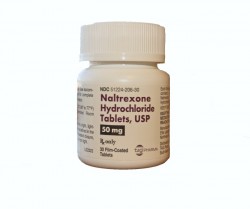How Does Rapid Detox Work?
There are different types of accelerated detox methods using antagonist medications to precipitate immediate opioid withdrawals with the expectancy of shortening their durations and minimizing their effects. Ultra-rapid detox treatments are commonly performed under heavy sedation or anesthesia with the procedures lasting 5-6 hours while rapid detox treatments use milder sedation methods for the duration of 1-5 days.
According to the SAMHSA, “Although there are few data showing that the rapid or ultra-rapid methods of opioid detoxification show a positive correlation with the likelihood of a patient’s being abstinent a few months later, efforts persist to make the detoxification process shorter and easier.”
The Use of Opioid Antagonist Medications in Rapid Detox

Naltrexone is an opioid antagonist medication.
Opiate dependency is a result of adaptations that take place in neuronal communications of nerve cells in the brain and central nervous system after repeat administrations and regular use of opioids. Brain functions and bodily systems come to rely on the presence of opioids to keep things running smoothly. When opioids enter the brain, they attach to opioid receptors to elicit these effects and as those attachments diminish, withdrawals result.
When an opioid antagonist drug, such as the naltrexone, is used in rapid detox, it enters the brain and has the power to displace those opiate molecules currently attached and block any others from entering and attaching to the receptors. According to the National Collaborating Centre for Mental Health (UK), “The aim is to flood the brain with an opioid antagonis to remove all agonists and fully occupy the opioid receptors.”
Immediately, an opiate dependent person will go into full withdrawals. Withdrawals by any traditional standard are painful and unpleasant, but, by experiencing the intense impact immediately can lead to life-threatening conditions and these procedures are not recommended as a routinely offered treatment.
How Does Ultra-Rapid Detox Work?
In an ultra-rapid detox, the person is put under heavy sedation or anesthesia when the withdrawal symptoms begin to appear shortly after administering the antagonist medication. Anesthesia is maintained for several hours so that the person bypasses the cognitive distress of the withdrawals and additional medications such as clonidine are used to reduce their intensity and effects.
In addition to clonidine, other non-opioid adjunct medications used for pain, nausea, vomiting, and diarrhea are also administered to control or alleviate the withdrawal symptoms not helped by the clonidine. Intensive medical monitoring and access to life-saving equipment and othe measures are necessary for at least 24 hours at which time the person is maintained for several days longer on the antagonist medication at home.
How Does Rapid Detox Work?
In a rapid detox, under moderate or mild sedation, the person is given medication such as a benzodiazepine to help keep them calm and minimize the distress and discomforts of the withdrawals expected to ensue after administering the antagonist medications. Adjunct medications may also be used to control or alleviate symptoms and the person may be maintained on the sedative and antagonist medications for several days.


 What Are Rapid Detox Centers, and How Can They Help? -
Rapid detox is a generally safe and effective way to overcome substance dependency within a relatively short period of time.
What Are Rapid Detox Centers, and How Can They Help? -
Rapid detox is a generally safe and effective way to overcome substance dependency within a relatively short period of time.  5 Benefits of Undergoing Rapid Opioid Detox -
Learn about the benefits of choosing a rapid detox program for your opioid addiction recovery.
5 Benefits of Undergoing Rapid Opioid Detox -
Learn about the benefits of choosing a rapid detox program for your opioid addiction recovery.  How Does Rapid Opiate Detox Work? -
Rapid opiate detox is shortened version of standard detox in which the user is quickly treated for opiate dependence using unconventional methods such as induced coma and intravenous medications. The procedure is performed in an intensive care unit in the hospital or in a hospital like setting in which 24-hour medical monitoring is provided. Here’s ...
How Does Rapid Opiate Detox Work? -
Rapid opiate detox is shortened version of standard detox in which the user is quickly treated for opiate dependence using unconventional methods such as induced coma and intravenous medications. The procedure is performed in an intensive care unit in the hospital or in a hospital like setting in which 24-hour medical monitoring is provided. Here’s ...  Potential Dangers of Rapid Opiate Detox -
Rapid opiate detox uses opioid antagonist medications such as naltrexone to displace opioids from the opioid receptors in the brain and central nervous system, essentially blocking and counteracting the opioid effects and precipitating withdrawals. The potential dangers of rapid opiate detox are well documented and the procedures remain controversial. About Rapid Opiate Detox According to ...
Potential Dangers of Rapid Opiate Detox -
Rapid opiate detox uses opioid antagonist medications such as naltrexone to displace opioids from the opioid receptors in the brain and central nervous system, essentially blocking and counteracting the opioid effects and precipitating withdrawals. The potential dangers of rapid opiate detox are well documented and the procedures remain controversial. About Rapid Opiate Detox According to ...  Pros and Cons of Rapid Detox Programs -
Rapid detox programs, though rather controversial, have both benefits and negative aspects associated with the help that is provided by them. Patients who are addicted to heroin or certain types of prescription painkillers such as Oxycontin or Oxycodone can benefit from rapid detox programs but only if they are aware of the importance of seeking ...
Pros and Cons of Rapid Detox Programs -
Rapid detox programs, though rather controversial, have both benefits and negative aspects associated with the help that is provided by them. Patients who are addicted to heroin or certain types of prescription painkillers such as Oxycontin or Oxycodone can benefit from rapid detox programs but only if they are aware of the importance of seeking ...